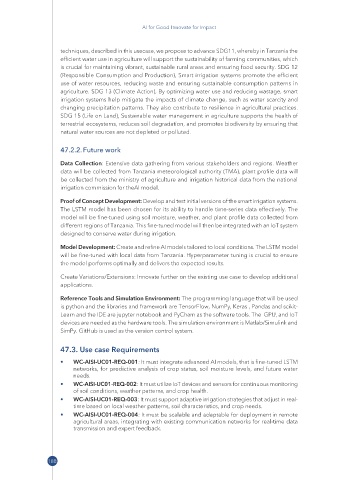Page 204 - AI for Good-Innovate for Impact
P. 204
AI for Good-Innovate for Impact
techniques, described in this usecase, we propose to advance SDG11, whereby in Tanzania the
efficient water use in agriculture will support the sustainability of farming communities, which
is crucial for maintaining vibrant, sustainable rural areas and ensuring food security. SDG 12
(Responsible Consumption and Production), Smart irrigation systems promote the efficient
use of water resources, reducing waste and ensuring sustainable consumption patterns in
agriculture. SDG 13 (Climate Action), By optimizing water use and reducing wastage, smart
irrigation systems help mitigate the impacts of climate change, such as water scarcity and
changing precipitation patterns. They also contribute to resilience in agricultural practices.
SDG 15 (Life on Land), Sustainable water management in agriculture supports the health of
terrestrial ecosystems, reduces soil degradation, and promotes biodiversity by ensuring that
natural water sources are not depleted or polluted.
47�2�2� Future work
Data Collection: Extensive data gathering from various stakeholders and regions. Weather
data will be collected from Tanzania meteorological authority (TMA), plant profile data will
be collected from the ministry of agriculture and irrigation historical data from the national
irrigation commission for theAI model.
Proof of Concept Development: Develop and test initial versions of the smart irrigation systems.
The LSTM model has been chosen for its ability to handle time-series data effectively. The
model will be fine-tuned using soil moisture, weather, and plant profile data collected from
different regions of Tanzania. This fine-tuned model will then be integrated with an IoT system
designed to conserve water during irrigation.
Model Development: Create and refine AI models tailored to local conditions. The LSTM model
will be fine-tuned with local data from Tanzania. Hyperparameter tuning is crucial to ensure
the model performs optimally and delivers the expected results.
Create Variations/Extensions: Innovate further on the existing use case to develop additional
applications.
Reference Tools and Simulation Environment: The programming language that will be used
is python and the libraries and framework are TensorFlow, NumPy, Keras , Pandas and scikit-
Learn and the IDE are jupyter notebook and PyCham as the software tools. The GPU, and IoT
devices are needed as the hardware tools. The simulation environment is Matlab/Simulink and
SimPy. GitHub is used as the version control system.
47�3� Use case Requirements
• WC-AISI-UC01-REQ-001: It must integrate advanced AI models, that is fine-tuned LSTM
networks, for predictive analysis of crop status, soil moisture levels, and future water
needs.
• WC-AISI-UC01-REQ-002: It must utilize IoT devices and sensors for continuous monitoring
of soil conditions, weather patterns, and crop health.
• WC-AISI-UC01-REQ-003: It must support adaptive irrigation strategies that adjust in real-
time based on local weather patterns, soil characteristics, and crop needs.
• WC-AISI-UC01-REQ-004: It must be scalable and adaptable for deployment in remote
agricultural areas, integrating with existing communication networks for real-time data
transmission and expert feedback.
188

